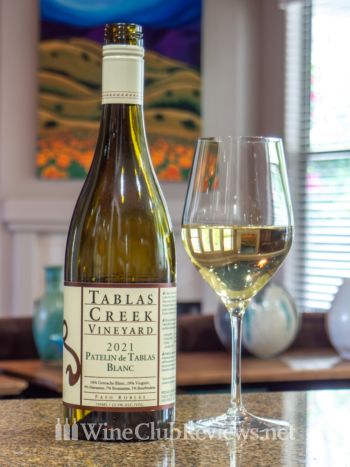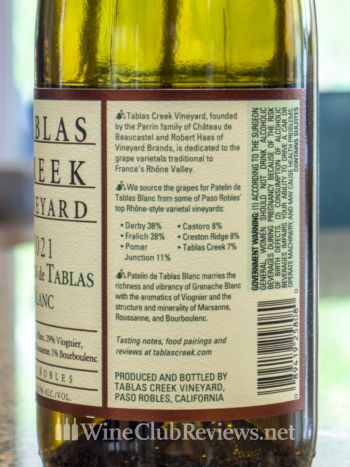Tablas Creek Vineyards Patelin de Tablas Blanc Review
This delightful blend of five different Rhone white grapes from six different wineries showcases the whole point of blending — to produce something better than the sum of its parts.
Wine review by: Jessyca Frederick |


FYI: I find great wine deals so you don’t have to. To keep me on the hunt, I earn a commission when you buy wine based on my recommendations.
About this Wine
Wine: 2021 Patelin de Tablas Blanc
Blend: 54% Grenache Blanc, 29% Viognier, 9% Marsanne, 7% Roussanne, 1% Bourboulenc
Region: Paso Robles, California
Vineyards: 38% Derby, 28% Fralich, 11% Pomar Junction, 8% Castoro, 8% Creston Ridge, 7% Tablas Creek
Retail price: $28
I consumed it: April 2023
My source: Tablas Creek Tasting Room
The Back Label

Discover More
From this winery: Tablas Creek Vineyards
Region: Paso Robles, Central Coast, California
Wine color/style: White wine
Grape variety or blend: White blends
Tasting notes: Apple, Low acid, Mineral
Other characteristics: Food friendly
Patelin de Tablas Blanc: What I think
Tablas Creek Vineyards is renowned for their environment-forward approach to just about everything. In addition to being the first certified Regenerative Organic winery in the US, they dry farm a not-insignificant portion of their vineyard, and they have started putting their wines in boxes.
Their Patelin de Tablas wines (one rouge, one blanc, and rosé) are not "estate" wines (though they invariably include some estate fruit). Instead they’re sourced from excellent vineyards around Paso Robles. This Patelin de Tablas Blanc is notable to me because it’s one of my go-to white wines and it’s almost all "East Side" fruit (which I’m normally quick to poo-poo because no matter how hard I try not to be, I’m still a wine snob sometimes).
Anyway, this delightful blend of five different Rhone white grapes from six different wineries showcases the whole point of blending — to produce something better than the sum of its parts. Each grape contributes something meaningful to the finished product: Grenache blanc is acidity and tree fruit, the Viognier adds viscosity and floral notes, the Marsanne adds depth and a touch of bitterness, the Roussanne is similar, but more like Viognier, and well I’m not skilled enough to detect that 1% Bourbelanc — though I’ve had their Bourbelanc and it’s bright and fruity.
More specifically, I smelled white fruit (maybe nectarine from the Viognier) and enjoyed an appley mid-palate (the Grenache Blanc), a hint of Meyer lemon (hey, maybe that was the Bourbelanc!), and a nice minerality supported by mild acidity.
Get the details at Tablas Creek.
Last updated: May 2, 2024
Notice: I hold no formal wine credentials. I am a wine geek who has consumed 1000+ of bottles from 100+ different wine clubs and 1000s more bottles that didn’t come from those wine clubs. I do not accept payment for wine reviews, and I do not accept payments to influence my opinions. I happily accept free wine (and I buy wine).
Why read my wine reviews: Wine taste is subjective. What I like may not be what you like. I try to leave room for you to form your own opinions, so I don’t provide a score or a rating. I do point out wines that are an incredible value or truly not worth the money. I note flaws, wines that don’t have typicity (because this matters if you are buying wine without having tasted it yourself), when wines are out of balance, and when wines lack appropriate body.
I don’t like wasting money (or anything for that matter). I’m careful about where I spend my money and my mindset as a reviewer is to be careful about where you spend yours. I don’t believe a high price tag equals quality and I know for sure there are wines of very good quality that are also a great value.
Learn more about me or get in touch.